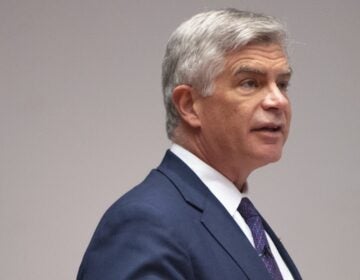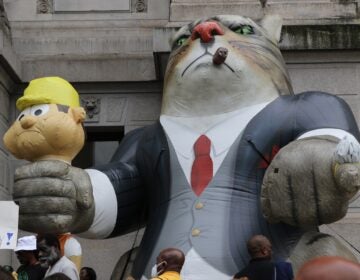East Falls joins the citywide green street celebration
Last week, city and community leaders descended upon the Philadelphia Water Department’s Queen Lane facility to “soak up” East Falls and celebrate the implementation of another green Philadelphia street.
The fifth in a series of outreach events scheduled around the city, “Soak it Up, Philly” is aimed at bringing attention to “green streets” – roadways that act as natural storm water management systems.
“Soak it Up, Philly” is a component of the Green City, Clean Waters campaign, which will invest approximately $2.4 billion over the next 25 years to combat stormwater and sewage runoff that occurs during major rain events, according to the PWD.
Promoting sustainability throughout the city
Speaking for the PWD, Deputy Commissioner Debra McCarty noted that Queen Lane in East Falls is one of the first streets in the city with vegetated curb bumpouts.
McCarty explained that 15 green streets have been completed to date, and that by the end of the year, construction will begin on an additional 215 green street blocks.
“This is just the tip of the iceberg,” she said, emphasizing PWD’s belief that green initiatives will benefit the city’s environmental, financial, and social well-being.
“We strive to ensure that we can successfully become an environmentally and socially sustainable city,” McCarty declared.
Gina Snyder, executive director of the East Falls Development Corporation, reinforced McCarty’s remarks that green streets are the result of “true collaboration” between government agencies and local entities.
“It’s been a real education for me,” she said, in reference to the personal road traveled in learning about the positive community impact of the efforts.
Fourth District Councilman Curtis Jones, Jr. was scheduled to speak at the event, but was prevented from attending. Joshua Cohen, special assistant to the councilman, reinforced the councilman’s commitment to green initiatives, and indicated that the councilman will continue to support this work through “innovative and groundbreaking green legislation.”
A ‘consciousness-raising opportunity’
PWD typically uses two forms of natural stormwater management systems. Stormwater tree trenches contain either a single or a series of trees that channel water into an underground filtration unit, according to PWD literature.
The second form – storm water bumpouts – resembles a traditional street bumpout but includes vegetation that intercepts storm water on the street during a rain event for ground infiltration, storage, or evapotranspiration – the transmission of water into the atmosphere from trees and soil.
Providing a more tangible of this process was Chelsea Heck and Trish Fries from the Wissahickon Environmental Center. Together, they conduct a large amount of outreach about stormwater infrastructure as part of their duties.
Standing behind a model of a green street, Heck and Fries poured water into a small grate that represented an open sewer installed on a non-porous roadway. The water poured directly into an adjoining basin, akin to stormwater running into the Schuylkill or Delaware Rivers.
When they poured water into a miniature bumpout – replete with soil and gravel bedding – no water was observed draining, reinforcing the efficacy of the system.
In response to the event, Tom Sauerman, president of East Falls Community Council, said he viewed it as a “consciousness-raising opportunity.”
“We need to take what’s here and go beyond it both collectively and individually,” he said, “at home and across the city.”
Illustrating how green streets work
In addition to stormwater retention, community leaders emphasized the traffic-calming potential of the bumpouts.
“The bumpouts were proposed as part of the common goal of slowing down traffic,” said Snyder.
However, she observed criticisms have been voiced regarding the bumpouts’ effectiveness in remediating traffic concerns.
In response to this, Snyder said that while the bumpouts will not act as a “cure-all,” the installations could be a start in slowing traffic on Queen Lane and elsewhere.
“Ultimately,” she said, “we might have solutions here.”
While this is the last “Soak it Up, Philly” event scheduled at present, Joanne Dahme, general manager of Public Affairs at PWD said that her organization is expecting to host a similar event in Northern Liberties in the spring, but no date has been established.
Asked to characterize city-wide response to “Soak It Up, Philly,” Dahme answered that it has been very supportive.
“We found these events to be great opportunities to illustrate how green streets work,” she said, emphasizing the environmentally-friendly capture of water that “improves the beauty of neighborhoods.”
WHYY is your source for fact-based, in-depth journalism and information. As a nonprofit organization, we rely on financial support from readers like you. Please give today.




